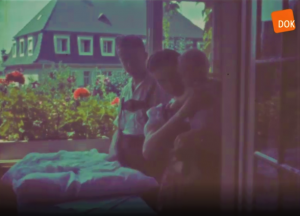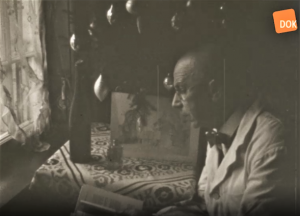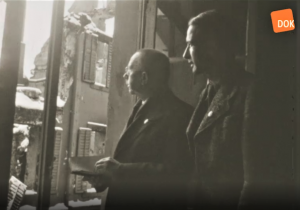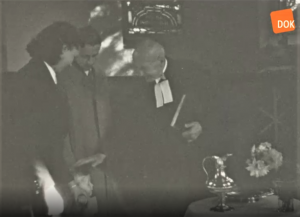Familienaufnahmen Taufe Enkel : Différence entre versions
| (8 révisions intermédiaires par le même utilisateur non affichées) | |||
| Ligne 22 : | Ligne 22 : | ||
|lieuTournage=48.01203, 7.86398 | |lieuTournage=48.01203, 7.86398 | ||
|thematique=Religious feasts and events@ Easter | |thematique=Religious feasts and events@ Easter | ||
| − | |Resume_de=Familienaufnahmen mit Enkel, Taufe, Weihnachten, Ostern | + | |Resume_en=Shots of the family with grandchildren, baptism, Christmas, Easter in the last year of WW II and beyond |
| + | |Resume_de=Familienaufnahmen mit Enkel, Taufe, Weihnachten, Ostern im letzten Kriegsjahr und danach | ||
| + | |Description_en=Young woman with baby; | ||
| + | Title: Pentecost 1944 / | ||
| + | Baby on changing table, family in garden, couple with stroller, parents with child, elderly man on ladder; | ||
| + | Title: Kati 24 Years 14.9.44 / | ||
| + | young woman with camera, mother and grandparents with baby, baby in stroller; | ||
| + | Title: August 5, 1944 / | ||
| + | Family with small child in the house and in the garden, small child in a stroller, stroll with a stroller; Cyclists on country road, in the background Oberglottertal; young woman welcomes man in Wehrmacht uniform, toddler in a stroller, panning over house and surroundings; | ||
| + | Title: 12/10/44 Kati and Peter in Glottertal evacuated from Freiburg / | ||
| + | Pan over Oberglottertal, bike with luggage, pan over house and surroundings; Family with small child in front of the house, stroll with a stroller, sign 'Gemeinde Oberglottertal'; | ||
| + | Title: 6th War Christmas 1944/45 / | ||
| + | War destruction on the market place in Freiburg; Grandparents with a small Christmas tree in a pot, grandfather with a mason jar, grandparents with buckets in front of the house, Christmas tree in the living room, older man with a bicycle, women come out of the house, snowy garden; View from the window of war-torn houses; | ||
| + | Title: Peter 1 year / | ||
| + | Oberglottertal, man in Wehrmacht uniform and with raincoat in front of a stream, toddler in a pram, parents (father in Wehrmacht uniform) with toddler on the balcony of a Black Forest house, saying goodbye in front of the house; Family with small child in front of the house; | ||
| + | Title: Peter's baptism on October 28, 1945 after a lost war and great need in the fatherland / | ||
| + | Boy with toys, mother with child, walk on the street; Baptism with pastor in the church; Grandfather with toddler in sports car; Walk on the street, family with children in the garden, child playing in the garden, men sawing logs in front of the house; | ||
| + | Title: Easter April 21, 1946 / | ||
| + | Boy with toys, family with children in the garden, boy with walking stick, walk. // | ||
|Description_de=Junge Frau mit Baby; | |Description_de=Junge Frau mit Baby; | ||
Titel: Pfingsten 1944 / | Titel: Pfingsten 1944 / | ||
| Ligne 41 : | Ligne 59 : | ||
Titel: Ostern 21.4.1946 / | Titel: Ostern 21.4.1946 / | ||
Junge mit Spielzeug, Familie mit Kindern im Garten, Junge mit Spazierstock, Spaziergang. // | Junge mit Spielzeug, Familie mit Kindern im Garten, Junge mit Spazierstock, Spaziergang. // | ||
| + | |Contexte_et_analyse_en=[[Fichier:Familienaufnahmen 1.png|vignette|Family idyll with the new child in color (Foto: LFS)]] | ||
| + | The almost ten-minute, silent private film by the Freiburg architect Curt Balke summarizes the most important events in the family between Pentecost 1944 and Eastern 1946. The focus of the recordings is now on the grandson Peter, born in 1944, who can be seen in many different shots. Since Curt Balke can also be seen regularly, other family members must also have operated the camera. So it's a family movie in the best sense of the word. | ||
| + | |||
| + | The film begins with a sign "Pentecost 1944" and shows the grandson on the changing table, which is taken care of by his mother. She picks him up and puts him in a stroller. Curt Balke comes from his house in Freiburg with a full tray and has his leather camera bag strapped on. He wants to be ready when a nice shooting situation arises with his grandson. The coffee table is set in a shady place in the garden. His son-in-law in lederhosen holds his grandson in his arms. Several times it is shown how the child is swaddled in the summer and lifted by its mother or sleeps in the stroller. For the family, the offspring is a moment of happiness in times of war and accordingly they are often recognized on film. | ||
| + | |||
| + | [[Fichier:Familienaufnahmen 2.png|vignette|War Christmas 1944 with a Christmas tree (Foto: LFS)]] | ||
| + | |||
| + | The date 5.8.1944 is placed on a stone in the garden, and now a color sequence begins. In the 16 mm format, color shots were possible from the mid-1930s, but the film material was even more expensive than black and white film. The images are a bit faded and have a greenish cast, but you still get an impression of the colourfulness of the time. The focus is still on the young family and the blooming garden at the family seat in Freiburg. The grandson is wearing knitted children's clothes. The family's dachshund can also be seen briefly. The son-in-law in uniform comes to visit. | ||
| + | |||
| + | [[Fichier:Familienaufnahmen 3.png|vignette|Destroyed house next door: the war is so close (Foto: LFS)]] | ||
| + | [[Fichier:Familienaufnahmen 4.png|vignette|Church baptism takes place after war (Foto: LFS)]] | ||
| + | |||
| + | On November 27, 1944, Freiburg is bombed by Allied air force units and the center is almost completely destroyed. The neighboring house of Balkes is also hit, her own house is spared. Nevertheless, the daughter and grandson are evacuated to Oberglottertal a little north of Freiburg on December 10th. Curt Balke visits her regularly by bike, has the camera with him and is shooting in black and white again. Together with his daughter in a fur coat, he takes a stroll through the snow-covered landscape with his stroller. | ||
| + | |||
| + | The next text informs: “6. War Christmas 1944/45 ”and Balke continues the tradition of taking pictures at Christmas. But first his pictures show the destroyed center of Freiburg. Such recordings were officially forbidden and therefore quite risky for him. In the next shot, his wife bends over a small Christmas tree in a pot in front of the house. He then carries it into the house. His daughter and grandson can be seen briefly in Glottertal. Curt Balke in a white coat and with a cigar in his mouth sets the table and has a bottle of milk in his hand. The next sequence shows him carrying two buckets to the house. There they are taken over by his wife. The water supply probably collapsed after the bombing and the water has to be fetched in buckets. It's an arduous Christmas with restrictions. Nevertheless, a Christmas tree is decorated with balls and at least a few gifts such as a picture, books, a bottle of scented water and a bottle of wine lie under the small tree. One sticks to traditions. His wife puts a rucksack on the bike with which he rides towards Glottertal. There is also a Christmas tree there, but it is far too dark and can only be made out vaguely. His daughter and another woman come out of the house and go back inside. The next shot shows the architect's house in Freiburg. There is some snow on the wall. Then the completely destroyed neighboring house can be clearly seen through the window. On his grandson's 1st birthday, in rainy weather, he set off on foot in the direction of Glottertal, where his son-in-law in the uniform of a paratrooper is also visiting. | ||
| + | |||
| + | [[Fichier:Familienaufnahmen 5.png|vignette|The grandson with a teddy bear in front of the Freiburg house (Foto: LFS)]] | ||
| + | |||
| + | The time of the film jumps to the baptism of the grandson on October 28th, 1945 and the tablet informs “after a lost war and great hardship in the fatherland”. The pan shows a festively laid table. The grandson is baptized in a church, after which there is a celebration at home with guests. The grandson can now walk, which is also shown by the next images, which were probably taken in spring 1946. There are no recordings of Christmas 1945, which breaks a long tradition. In the garden, logs are cut into short pieces of wood with a circular saw. The conclusion is formed by recordings from Easter on April 21, 1946 with an Easter egg hunt in the garden. The grandson in lederhosen, traditional shirt and cap is given a rocking horse. | ||
| + | Kay Hoffmann | ||
| + | |Contexte_et_analyse_de=[[Fichier:Familienaufnahmen 1.png|vignette|Familienidylle mit Kind in Farbe (Foto: LFS)]] | ||
| + | Der knapp zehnminütige, stumme Privatfilm des Freiburger Architekten Curt Balke fasst die wichtigsten Ereignisse in der Familie zwischen Pfingsten 1944 und Ostern 1946 zusammen. Im Mittelpunkt der Aufnahmen steht nun der 1944 geborene Enkel Peter, der in sehr vielen Einstellungen zu sehen ist. Da auch Curt Balke regelmäßig selbst zu sehen ist, müssen auch andere Familienmitglieder die Kamera bedient haben. So ist es ein Familienfilm im besten Sinn. | ||
| + | |||
| + | Der Film beginnt mit einer Tafel „Pfingsten 1944“ und zeigt den Enkel auf dem Wickeltisch, der von seiner Mutter versorgt wird. Sie nimmt ihn hoch und legt ihn in einen Kinderwagen. Curt Balke kommt mit einem vollen Tablett aus seinem Haus in Freiburg und hat die Kameratasche aus Leder umgeschnallt. Er will bereit sein, wenn sich eine schöne Aufnahmesituation mit seinem Enkel ergibt. Der Kaffeetisch ist an einem schattigen Platz im Garten gedeckt. Sein Schwiegersohn in Lederhose hält den Enkel auf dem Arm. Mehrmals wird gezeigt, wie das Kind im Sommer gewickelt und von seiner Mutter in die Höhe gehoben wird oder im Kinderwagen schläft. Für die Familie ist der Nachwuchs ein Glücksmoment in Zeiten des Krieges und entsprechend oft wird er filmisch gewürdigt. | ||
| + | |||
| + | [[Fichier:Familienaufnahmen 2.png|vignette|Kriegsweihnacht 1944 mit Weihnachtsbaum (Foto: LFS)]] | ||
| + | |||
| + | Auf einen Stein im Garten ist das Datum 5.8.1944 gelegt, und nun beginnt eine Sequenz in Farbe. Im 16 mm-Format waren Farbaufnahmen ab Mitte der 1930er Jahre möglich, das Filmmaterial war allerdings noch teurer als Schwarzweißfilm. Die Aufnahmen sind etwas verblasst und grünstichig, trotzdem bekommt man einen Eindruck von der damaligen Farbigkeit. Im Mittelpunkt steht weiterhin die junge Familie und der blühende Garten am Familiensitz in Freiburg. Der Enkel hat gestrickte Kinderkleidung an. Kurz ist auch der Dackel der Familie zu sehen. Der Schwiegersohn in Uniform kommt zu Besuch. | ||
| + | |||
| + | [[Fichier:Familienaufnahmen 3.png|vignette|Zerstörtes Nachbarhaus: so nah ist der Krieg (Foto: LFS)]] | ||
| + | [[Fichier:Familienaufnahmen 4.png|vignette|Die kirchliche Taufe findet nach dem Krieg statt (Foto: LFS)]] | ||
| + | |||
| + | Am 27. November 1944 wird Freiburg von Alliierten Luftwaffenverbänden bombardiert und das Zentrum nahezu vollständig zerstört. Auch das Nachbarhaus von Balkes wird getroffen, ihr eigenes Haus bleibt verschont. Trotzdem werden die Tochter und der Enkel am 10. Dezember nach Oberglottertal etwas nördlich von Freiburg evakuiert. Curt Balke besucht sie regelmäßig mit dem Fahrrad, hat die Kamera dabei und dreht wieder schwarzweiß. Zusammen mit seiner Tochter im Pelzmantel macht er einen Spaziergang mit dem Kinderwagen durch die verschneite Landschaft. | ||
| + | Die nächste Tafel informiert: „6. Kriegsweihnacht 1944/45“ und Balke setzt die Tradition fort, zu Weihnachten Aufnahmen zu machen. Aber zunächst zeigen seine Bilder das zerstörte Zentrum von Freiburg. Solche Aufnahmen waren offiziell verboten und deshalb durchaus riskant für ihn. In der nächsten Einstellung bückt sich seine Frau über einen kleinen Weihnachtsbaum in einem Topf, der vor dem Haus steht. Er trägt ihn dann ins Haus. Kurz sind seine Tochter und sein Enkel im Glottertal zu sehen. Curt Balke im weißen Kittel und mit Zigarre im Mund deckt den Tisch und hat eine Flasche Milch in der Hand. Die nächste Sequenz zeigt ihn, wie er zwei Eimer zum Haus trägt. Dort werden sie von seiner Frau übernommen. Wahrscheinlich ist nach dem Bombenangriff die Wasserversorgung zusammengebrochen und das Wasser muss in Eimern geholt werden. Es ist ein beschwerliches Weihnachtsfest mit Einschränkungen. Trotzdem wird ein Weihnachtsbaum mit Kugeln geschmückt und zumindest ein paar Geschenke wie ein Bild, Bücher, ein Flasche Duftwasser und eine Flasche Wein liegen unter dem kleinen Baum. Man hält an Traditionen fest. Seine Frau packt einen Rucksack auf das Fahrrad, mit dem er Richtung Glottertal fährt. Auch dort steht ein Weihnachtsbaum, der allerdings viel zu dunkel aufgenommen und nur schemenhaft zu erkennen ist. Seine Tochter und eine weitere Frau kommen aus dem Haus und gehen wieder hinein. Die nächste Einstellung zeigt das Haus des Architekten in Freiburg. Auf der Mauer lieg etwas Schnee. Dann ist durch das Fenster deutlich das völlig zerstörte Nachbarhaus zu sehen. Zum 1. Geburtstag seines Enkels macht er sich bei regnerischem Wetter zu Fuß auf in Richtung Glottertal, wo auch sein Schwiegersohn in der Uniform eines Fallschirmjägers zu Besuch ist. | ||
| + | |||
| + | [[Fichier:Familienaufnahmen 5.png|vignette|Der Enkel mit einem Teddybär vor dem Freiburger Haus (Foto: LFS)]] | ||
| + | |||
| + | Zeitlich springt der Film zur Taufe des Enkels am 28.10.1945 und die Schrifttafel informiert „nach verlorenem Krieg und grosser Not im Vaterland“. Der Schwenk zeigt einen festlich gedeckten Tisch. Der Enkel wird in einer Kirche getauft, anschließend wird zu Hause mit Gästen gefeiert. Der Enkel kann inzwischen laufen, was auch die nächsten Aufnahmen zeigen, die vermutlich im Frühjahr 1946 entstanden. Vom Weihnachtsfest 1945 gibt es keine Aufnahmen, was eine lange Tradition durchbricht. Im Garten werden mit einer Kreissäge Holzstämme in kurze Scheite zersägt. Den Abschluss bilden Aufnahmen vom Osterfest am 21.4.1946 mit einer Ostereiersuche im Garten. Der Enkel in Lederhose, mit Trachtenhemd und Käppi bekommt ein Schaukelpferd geschenkt. | ||
| + | Kay Hoffmann | ||
}} | }} | ||
Version actuelle datée du 8 avril 2021 à 14:50
Résumé
Contexte et analyse
The almost ten-minute, silent private film by the Freiburg architect Curt Balke summarizes the most important events in the family between Pentecost 1944 and Eastern 1946. The focus of the recordings is now on the grandson Peter, born in 1944, who can be seen in many different shots. Since Curt Balke can also be seen regularly, other family members must also have operated the camera. So it's a family movie in the best sense of the word.
The film begins with a sign "Pentecost 1944" and shows the grandson on the changing table, which is taken care of by his mother. She picks him up and puts him in a stroller. Curt Balke comes from his house in Freiburg with a full tray and has his leather camera bag strapped on. He wants to be ready when a nice shooting situation arises with his grandson. The coffee table is set in a shady place in the garden. His son-in-law in lederhosen holds his grandson in his arms. Several times it is shown how the child is swaddled in the summer and lifted by its mother or sleeps in the stroller. For the family, the offspring is a moment of happiness in times of war and accordingly they are often recognized on film.
The date 5.8.1944 is placed on a stone in the garden, and now a color sequence begins. In the 16 mm format, color shots were possible from the mid-1930s, but the film material was even more expensive than black and white film. The images are a bit faded and have a greenish cast, but you still get an impression of the colourfulness of the time. The focus is still on the young family and the blooming garden at the family seat in Freiburg. The grandson is wearing knitted children's clothes. The family's dachshund can also be seen briefly. The son-in-law in uniform comes to visit.
On November 27, 1944, Freiburg is bombed by Allied air force units and the center is almost completely destroyed. The neighboring house of Balkes is also hit, her own house is spared. Nevertheless, the daughter and grandson are evacuated to Oberglottertal a little north of Freiburg on December 10th. Curt Balke visits her regularly by bike, has the camera with him and is shooting in black and white again. Together with his daughter in a fur coat, he takes a stroll through the snow-covered landscape with his stroller.
The next text informs: “6. War Christmas 1944/45 ”and Balke continues the tradition of taking pictures at Christmas. But first his pictures show the destroyed center of Freiburg. Such recordings were officially forbidden and therefore quite risky for him. In the next shot, his wife bends over a small Christmas tree in a pot in front of the house. He then carries it into the house. His daughter and grandson can be seen briefly in Glottertal. Curt Balke in a white coat and with a cigar in his mouth sets the table and has a bottle of milk in his hand. The next sequence shows him carrying two buckets to the house. There they are taken over by his wife. The water supply probably collapsed after the bombing and the water has to be fetched in buckets. It's an arduous Christmas with restrictions. Nevertheless, a Christmas tree is decorated with balls and at least a few gifts such as a picture, books, a bottle of scented water and a bottle of wine lie under the small tree. One sticks to traditions. His wife puts a rucksack on the bike with which he rides towards Glottertal. There is also a Christmas tree there, but it is far too dark and can only be made out vaguely. His daughter and another woman come out of the house and go back inside. The next shot shows the architect's house in Freiburg. There is some snow on the wall. Then the completely destroyed neighboring house can be clearly seen through the window. On his grandson's 1st birthday, in rainy weather, he set off on foot in the direction of Glottertal, where his son-in-law in the uniform of a paratrooper is also visiting.
The time of the film jumps to the baptism of the grandson on October 28th, 1945 and the tablet informs “after a lost war and great hardship in the fatherland”. The pan shows a festively laid table. The grandson is baptized in a church, after which there is a celebration at home with guests. The grandson can now walk, which is also shown by the next images, which were probably taken in spring 1946. There are no recordings of Christmas 1945, which breaks a long tradition. In the garden, logs are cut into short pieces of wood with a circular saw. The conclusion is formed by recordings from Easter on April 21, 1946 with an Easter egg hunt in the garden. The grandson in lederhosen, traditional shirt and cap is given a rocking horse.
Kay HoffmannLieux ou monuments
- Aller ↑ Cette fiche est en cours de rédaction. À ce titre elle peut être inachevée et contenir des erreurs.











